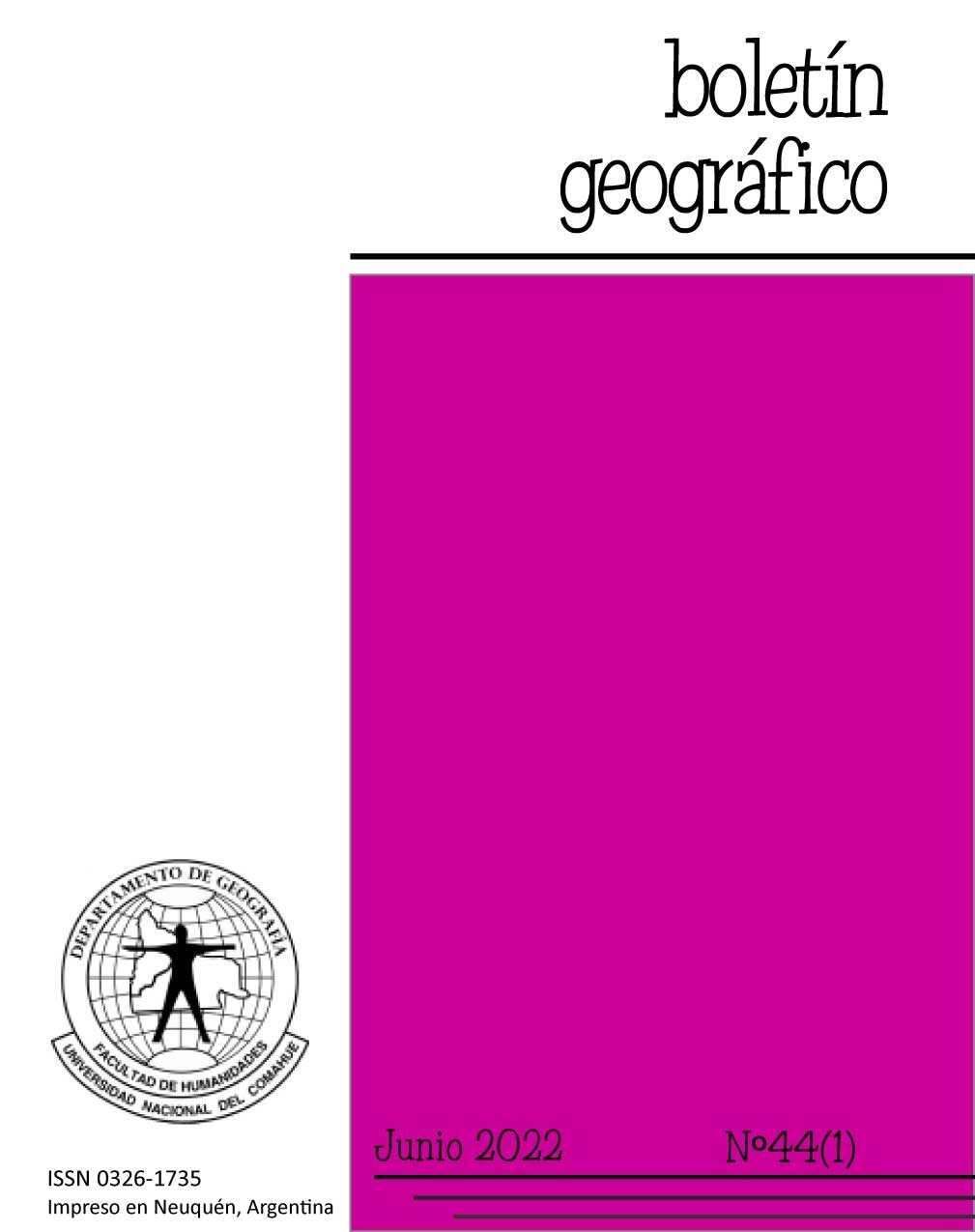Morphometric characteristics of the basin of the Huitzilac River, Puebla, Mexico
Keywords:
drainage network, hypsometric curve, hydrological maturity , erosive potential , floodingAbstract
MexicoAbstractThe spatial framework of this study was the basin of the Huitzilac River, located geographically towards the southwest of the state of Puebla, Mexico. This paper analyzes the morphometric parameters of the Huitzilac River basin and its drainage network in order to understand its surface dynamics. To do this, quantitative indicators and Geographic Information Systems (GIS) were used. The information was completed with fieldwork. The main results show that the basin has an area of 615 km2, so it is classified as "intermediate to large". The values of form factor, circularity ratio, and elongation ratio parameters, suggest an elongated shape with a tendency to a rectangular-oblong configuration. It is a fifth-order system with a drainage pattern mainly in the dendritic to sub-dendritic type. The hypsometric curve and the circularity ratio factor show a relative equilibrium or maturity stage, implying an erosive potential, mainly at the upstream area of the study area, which should not underestimate. In general, the morphometric characteristics attenuate some negative effects, due to possible flooding.
Downloads
References
Baba Hamed, K. & Bouanani, A. (2016). Caractérisation d’un bassin versant par l’analyse statistique des paramètres morphométriques: Cas du bassin versant de la Tafna. (Nord-ouest algérien). Geo-Eco-Trop, 40 (4), 277-286.
Bali, Rameshwar, Agarwal, K.K., & Nawaz Ali, S. (2012). Drainage morphometry of Himalayan Glacio-fluvial basin, India: hydrologic and neotectonic implications. Environmetal Earth Sciences (2012) 66:1163–1174. DOI 10.1007/s12665-011-1324-1
Becerra Moreno, A. (2005). Escorrentía, erosión y conservación de suelos. Universidad Autónoma Chapingo. Texcoco, Edo. de México.
Campos Aranda, D.F. (1998). Procesos de ciclo hidrológico. Editorial Universitaria Potosina. Tercera reimpresión.
Castillo, V., Díaz Segovia, A. & Alonso, S. G. (1988). Quantitative study of fluvial landscapes, case study in Madrid, Spain. Landscape and Urban Planning, 16, 201–217.
Chandniha Surendra, K., & Kansal Lal, M. (2017). Prioritization of sub-watersheds based on morphometric analysis using geospatial technique in Piperiya watershed, India. Applied Water Science, 7, 329–338. DOI 10.1007/s13201-014-0248-9.
Chopra R, Dhiman R.D., & Sharma P.K. (2005) Morphometric analysis of sub-watersheds in Gurdaspur district, Punjab using remote sensing and GIS techniques. Journal of Indian Society of Remote Sensing, 33(4), 531–539.
Cruz Romero, B., Gaspari, F. J., Rodríguez Vagaria, A. M., Carrillo González, F. M. & Téllez López. J. (2015). Análisis morfométrico de la cuenca hidrográfica del río Cuale, Jalisco, México. Investigación y Ciencia, 23(64), 26-34.
Díaz Delgado, C; Mamadou Bâ, K.; Iturbe Posadas, A.; Esteller, M.V.; & Reyna Sáenz, F. (1999). Estimación de las características fisiográficas de una cuenca con la ayuda de SIG y MEDT: caso del curso alto del río Lerma, Estado de México. Ciencia Ergo Sum, 6 (2), 124-134.
Dourojeanni, Axel C. (2002). ¿Quién gobierna a quién en la gestión del agua?. División de Recursos Naturales e Infraestructura. Publicación de Las Naciones Unidas. Santiago de Chile.
Esper Angillieri, M.Y., & Perucca, L. P. (2014). Caracterización morfométrica de la Cuenca del río Seco a propósito de las fuertes precipitaciones de enero de 2013, Departamento Sarmiento, San Juan, Argentina. Boletín de la Sociedad Geológica Mexicana, 66 (2), 235-245.
Farhan Isa, Y., Ahnbar Dawod, A., Enaba, O. & Al-shaikh, N. (2015). Quantitative Analysis of Geomorphometric Parameters of Wadi Kerak, Jordan, Using Remote Sensing and GIS. Journal of Water Resource and Protection, 456-475.
Faye, C. (2018). Caractérisation d’un bassin versant par l’analyse statistique des paramètres morphométriques : cas du bassin versant de la Gambie (bassin continental Guineo-Sénégalais). Revue Marocaine de Géomorphologie, 2, 110- 127.
Fuentes Junco, J. A. (2004). Análisis morfométrico de cuencas: caso de estudio del parque nacional pico de Tancítaro. México: Instituto Nacional de Ecología.
Garavaglia, J. C. & Ciezar Thiériot, L. (1995). Atlixco: l'eau, les hommes et la terre dans une vallée mexicaine (XVe-XVIIe s.), Annales, histoire, Sciences sociales, 50 (6), 1309-1349.
Gaspari, F. J., Rodríguez Vagaria, A. M., Senisterra, E. G., Denegri, A. G., Delgado, M.I. & Besteiro, S. (2012). Caracterización morfométrica de la cuenca alta del río Sauce Grande, Buenos Aires, Argentina. AUGMDOMUS, 4, 143-158.
Gaspari, F. J., Senisterra, G. E., Delgado, M. I., Rodríguez Vagaria, A.M. & Besteiro, S. (2009). Manual de Manejo Integral de Cuencas Hidrográficas. 1 ed. Editorial Autores.
Geraldi, A. M., Piccolo, M.C., & Perillo, G. M. E. (2010). Delimitación y estudio de cuencas hidrográficas con modelos hidrológicos. Investigaciones Geográficas (Esp), 52, 215-225.
Gil, V. (2011). Geomorfología fluvial de la cuenca del arroyo El Negro, Buenos Aires, Argentina. Revista Universitaria de Geografía, 20, 151-169.
Guerra, F. & González, J. (2002). Caracterización morfométrica de la cuenca de la quebrada la Bermeja, San Cristóbal, estado Táchira, Venezuela. Geoenseñanza, 7 (1-2), 88-108.
Guevara Gutiérrez, R. D., Olguín López, J. L., Mancilla Villa, O. R., Barreto & García, O. A. (2019). Análisis morfométrico de la cuenca hidrográfica del río Ayuquila, Jalisco-México. GeoFocus, 24, 141-158. ISSN: 1578-5157 http://dx.doi.org/10.21138/GF.622.
Gravelius, H. (1914): Flusskunde. Goschen Verlagshan dlug Berlin. En Zavoianu, I. (1985): Morphometry of Drainage Basins. Amsterdam, Elsevier.
Henaos Sarmiento, J. E. (1988). Introducción al manejo de cuencas hidrográficas. Bogotá: Universidad Santo Tomás. Centro de enseñanza desescolarizada.
Horton, R. E. (1932). Drainage-basin characteristics. Transactions, 13(1), 350-361.
Horton, R. E. (1945). Erosional development of streams and their drainage basins: Hydrophysical approach to quantitative morphology. Geological Society of America Bulletin, 56, 275-370.
Ibisate, A. (2004): Las crecidas fluviales en el Zadorra: procesos, riesgos y propuestas de ordenación. Tesis doctoral.
INEGI (2001a). Conjunto de datos vectoriales fisiográficos. Continuo Nacional serie I. Provincias fisiográficas. Escala 1:1 000 000.
INEGI (2001b). Conjunto de datos vectoriales fisiográficos. Continuo Nacional serie I. Sistema topoformas. Escala 1:1 000 000
INEGI (2013). Continuo de Elevaciones Mexicano 3.0 (CEM 3.0). ITRF92 época 1988.
INEGI (2017). Anuario estadístico y geográfico de Puebla.
INEGI (2020). Conjunto de datos vectoriales de información topográfica E14B52 Atlixco, Escala 1:50 000, Proyección UTM, México.
Keller, E. & Pinter, N. (1996). Active tectonics: Earthquakes, Uplift and Landscape. New Jersey: Prentice Hall.
López Cadenas de Llano, F. (1998). Restauración Hidrológica Forestal de cuencas y Control de la Erosión. Ingeniería Medioambiental, TRAGSATEC, Ministerio de Medio Ambiente. España: Editorial Mundi Prensa.
Mahala, A. (2020). The significance of morphometric analysis to understand the hydrological and morphological characteristics in two diferent morpho climatic settings. Applied Water Science, 10 (33), 1-16.
Maidment, D. R. (1992). Handbook of Hydrology. New York: McGraw Hill.
Mármol, L. (2008). Introducción al Manejo de Cuencas Hidrográficas y Corrección de Torrentes. Universidad Nacional de Salta. Salta.
Méndez Gutiérrez, A. G., Corral Rivas, S., Nájera Luna, J. A., Cruz Cobos F. & Pompa García, M. (2021). Análisis morfométrico de la cuenca El Salto, Durango, México. Terra Latinoamericana, 39, 1-11. e641. https://doi.org/10.28940/terra.v39i0.641
Méndez, W., Córdova, J. R., & Cartaya, S. (2005). Relaciones morfometría – respuesta hidrológica en La microcuenca de drenaje de la quebrada curucutí (estado Vargas, Venezuela), y su aplicación en la Evaluación de la amenaza por inundaciones. Anais do XI Simpósio Brasileiro de Geografia Física Aplicada. Realizado del 05 al 09 de septiembre.
Meza Rodríguez, M., & Martínez Rivera, L.M. (2010). Análisis morfométrico de las cuencas de la red Mexlter: estudio de diez cuencas a nivel nacional en México.
Miller, V. C. (1957): A quantitative geomorphic study of drainage basin characteristics in the Clinch Mountain area, Virginia and Tennessee. Office of Naval Research, Geography Branch, Project NR 389-042, Technical Report, 3, Columbia University.
NASA (2011). ASTER Global Digital Elevation Map V2: disponible en <https://search.earthdata.nasa.gov/search.
Patton, P. C. (1988). Drainage basin morphometry and floods. En Baker, V. R.; Kochel, R .C. & Patton, P.C. (Eds.), Flood geomorphology, 51-64. New York, Wiley.
Romshoo Shakil, A, Shakeel Ahmad, B. & Irfan, R. (2012). Geoinformatics for assessing the morphometric control on hydrological response at watershed scale in the Upper Indus Basin J. Earth Syst. Sci, 121(3), 659–686.
Sala, M. & Gay, R. (1981). Algunos datos morfométricos de la cuenca del Isábena. Notes de Geografía Física, 4, 41-65.
Sánchez Vélez, A.S, García Núñez, R.M., & Palma Trujano, A. (2003). La cuenca hidrográfica: unidad básica de planeación y manejo de recursos naturales. SEMARNAT, CONAGUA.
Senciales González, J. (1999). Redes fluviales. Metodología de análisis. España: Universidad de Malaga.
Schumm, S. A. (1956). Evolution of drainage systems and slopes in badlands at Perth Amboy, New Jersey. Bulletin of the Geological Society of America, 67, 597–646.
Sreedevi, P. D., Subrahmanyam, K., & Shakeel, A. (2005). The significance morphometric analysis for obtaining groundwater potential zones in structurally controlled terrain. Environ Geol, 47, 412–420.
Strahler, A. N. (1952). Hypsometric analysis (area-altitude) of erosional topography. Geological Society of America Bulletin, 63, 117–142.
Strahler, A. N. (1957). Quantitative analysis of watershed geomorphology. Transactions of American Geophysics Union, 38, 913–920.
Strahler, A. N. (1964). Quantitative geomorphology of basins and channel networks. En Chow, V.T. (ed.) Handbook of applied hydrology. New York: McGraw Hill Book Company, 4-36.
Témez, J. (1978). Cálculo Hidrometeorológico de caudales máximos en pequeñas cuencas naturales. Dirección General de Carreteras. Madrid. España. https://www2.mitma.es/recursos_mfom/0610400.pdf
Vidal, A. M.R., Montes, C., Suárez, M. L., Ramírez, D. L. (1987). Caracterización morfométrica de la cuenca del río Segura: Estudio cuantitativo de las formas de las subcuencas. Papeles de Geografía, 12, 19-31.
Viramontes Olivas, O. A., Escoboza García, L. F., Pinedo Álvarez, C., Reyes Gómez, V. M., Román Calleros, J. A.& Pérez Márquez, A. (2008). Morfometría de la cuenca del río San Pedro, Conchos, Chihuahua. Tecnociencia Chihuahua, I (3), 21-31.
Veltri, M., Veltri, P., & Maiolo, M. (1996). On the fractal dimension of natural channel network. Journal of Hydrology, 187, 137-144.
Published
How to Cite
Issue
Section
ARK
License
Copyright (c) 1969 Boletin GeográficoTransfer of rights and data processing
The acceptance of an article for publication in the Journal Geographic Bulletin implies the cession of the rights of printing and reproduction, by any means and means, of the author in favor of the Department of Geography of the National University of Comahue, which will not reject any request reasonable for the authors to obtain permission to reproduce their contributions. The total or partial reproduction of the works published in the Geographic Bulletin must be done citing the origin, otherwise, the copyright is violated.
Likewise, it is understood that the concepts and opinions expressed in each work are the sole responsibility of the author, without being responsible or in solidarity, necessarily, neither the editorial staff nor the editorial staff.
It is the responsibility of the authors to be able to provide interested readers with copies of the raw data, procedure manuals, scores and, in general, relevant experimental material.
Likewise, the Management of the journal guarantees the appropriate treatment of personal data
COPYRIGHT TRANSFER FORM

















 Journal of the
Journal of the 